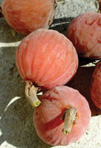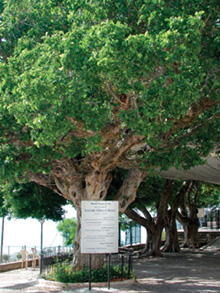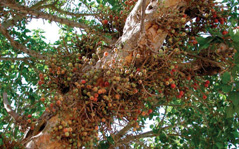

Sycomore fruits in May, from Sidon, Lebanon
BIBLE READERS ARE OFTEN SURprised that the diminutive tax collector, Zacchaeus, climbed up in a kind of fig tree to be able to see Jesus: “And, behold, there was a man named Zacchaeus, which was the chief among the publicans, and he was rich. And he sought to see Jesus who he was; and could not for the press, because he was little of stature. And he ran before, and climbed up into a sycamore tree to see him: for he was to pass that way” (Luke 19:1–4, KJV). Though this translation is close to the original Greek, there has been confusion about the identity of “sycamore.”
That this tree is Ficus sycomorus seems unequivocal. The Hebrew is shawkawm and the Greek sukaminos, similar words for this important tree. The sycomore fig is unrelated to the common sycamore (Platanus occidentalis) of the Eastern United States. Likewise, the English sycamore is actually a maple (Acer pseudoplatanus). The imputation of Bible plant names into local flora is a common phenomenon, especially since the translators of the influential King James Version had little first-hand knowledge of plants of the Middle East.
Sycomore (the preferred spelling) is a large tree up to 10 meters (30 feet) tall with a spreading crown and large, leathery, alternate leaves. Flowers are minute and borne in specialized structures termed “syconia” (singular “syconium”). Syconia are found only in this genus and represent a highly evolved pollination structure involving minute wasps. Inside the flask-shaped syconium are the unisexual flowers, stripped of all color and display. Some of the pistillate (female) flowers have long styles; others have short styles. The commensal relationship between insects and flowers is essential to the existence of both organisms. Today, however, many varieties of figs (both the common fig and the sycomore fig) are parthenocarpic: they can produce fruits without the benefit of insects.

Old, protected sycomore tree at Our Lady of Mantara Church, in May, in Sidon, Lebanon. When sycomore fruits mature, local citizenry come to gather them.

Ripe sycomore fruits on old tree, Sidon, Lebanon.
An intriguing reference is made to the sycomore fig and its culture by the prophet Amos: “‘I am not a prophet,’ Amos replied to [King] Amaziah, ‘nor do I belong to a prophetic brotherhood. I am merely a herdsman and dresser of sycomore-figs’” (Amos 7:14, NJB). Specifically what is the role of a dresser of sycamore figs, like Amos? With a sharp knife he would gash the developing fruits about four days before harvest. The cut releases ethylene gas and stimulates fruit production without fertilization. Such gashes are present on sycomore figs retrieved from Egyptian tombs of the eleventh century BC (Galil 1968). Zaleman (1980) gives linguistic support to “gasher” rather than gatherer or dresser of the developing fruit.
Gashing was a way to ripen fruit without the involvement of insects, bypassing one of the most elegant plant-insect relationships. The wasp that fertilizes the sycomore fig, Ceratosolen arabicus, is dependent on the sycomore fig. Likewise, the sycomore fig, unless it is parthenocarpic, will not produce fruit without the wasp. The deceivingly drab syconium is actually a chamber for many activities, including wasp mating, gas exchange, wasp egg hatching, and fruit development—all with elegant timing beginning with a female wasp entering the syconium. When she enters, covered with pollen from visiting previous flowers, she pushes aside the scales that occlude the ostiole, the small opening at the top of the syconium. Once inside, she lays eggs only in the short-styled flowers, allowing the long-styled flowers to produce seed because they are not damaged.
As the syconium develops, the carbon dioxide level increases in the closed chamber. The first wasps to hatch are male, which tolerate the higher carbon dioxide level. They drill through the wall of the ovaries to mate with the female wasps, which have developed from the eggs laid in the flowers, and then proceed to make a hole in the syconium wall. With the ingress of air through the opening to the outside, the carbon dioxide level inside the syconium falls. This stimulates the gravid females to break out of the flowers and allows them to fly to another syconium, where the drama is repeated. The altruistic male wasps simply die within the syconium or fall to the ground.
The sycomore is native to East Africa but was brought to the Nile Valley (Galil 1977), where it was used for boats, sculpture, and coffins (Meiggs 1982), as well as for food. Then the tree was probably introduced to the Middle East thousands of years ago.
Sycomore was widely planted in Israel in Bible times: “And the king made silver to be in Jerusalem as stones, and cedars made he to be as the sycamore trees that are in the vale, for abundance” (I Kings 10:27, KJV; II Chronicles 1:15, 9:27). King David had a royal grove of the trees: “Baal-Hanan the Gederite was in charge of the olive and sycamore-fig trees in the western foothills” (I Chronicles 27:28, NIV). Today, few large trees remain. Most have been cut to make coffins, since the sycomore fig is one of the few trees in the region to obtain sufficient girth for this use. For this reason, sycomore wood was also valuable for ship timbers, sculpture, and sarcophagi (Meiggs 1982).
The best-known sycomore in the Bible is the one mentioned in Luke 19, climbed by the unpopular tax gatherer, Zacchaeus. There are numerous large sycomore trees in present-day Jericho, but the tree singled out for display to tourists as Zacchaeus’s tree is about 2000 years too young, and it is not Ficus sycomorus.
Because sycomore is one of the largest trees in the region, it is a symbol of something established and difficult to move: “He [Jesus] replied, ‘If you have faith as small as a mustard seed, you can say to this mulberry [sukaminos] tree, “Be uprooted and planted in the sea,” and it will obey you’” (Luke 17:6, NLT). This verse is best understood by knowing that the “mulberry,” or more accurately “sycamine” (KJV) or “sycamore” (MSG), can be a large tree. This fits the imagery of the mountain—a large object for faith to overcome.
The fruits of Ficus sycomorus are no longer important commercially, although I have eaten sycomore figs sold in the market in Gaza, and the fruits are collected by local residents in Sidon, Lebanon. The taste is pleasant and sweet. They are considerably smaller than the common fig, but were once widely eaten.